Macroeconomic Analysis: Economic Policy and Japan's Global Role
VerifiedAdded on 2023/05/27
|12
|3438
|322
Report
AI Summary
This report analyzes the economic concepts related to macroeconomic events in Japan, focusing on the Bank of Japan's adoption of ultra-loose monetary policy. It discusses the impact of this policy on interest rates and aggregate demand, as well as the economic challenges faced by the Japanese economy, such as deflation and income inequality. The report also explores the rationale behind the Bank of Japan's policy choices, including forward guidance and quantitative easing, aimed at achieving a 2% inflation target and stimulating economic growth. The analysis incorporates economic models and diagrams to illustrate the effects of monetary policy on interest rates, aggregate demand, and overall economic stability in Japan. The report concludes by reflecting on the effectiveness and potential externalities of these policies.
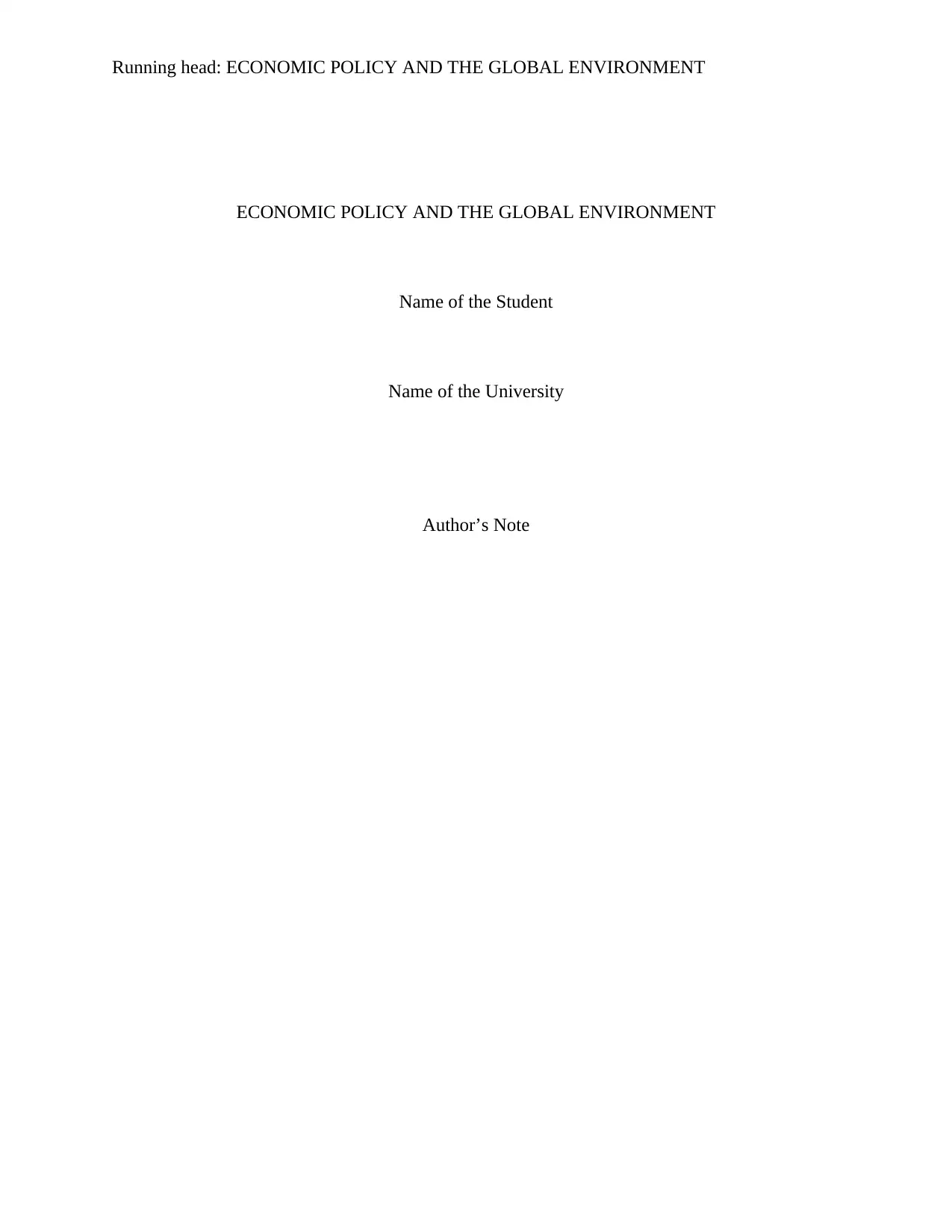
Running head: ECONOMIC POLICY AND THE GLOBAL ENVIRONMENT
ECONOMIC POLICY AND THE GLOBAL ENVIRONMENT
Name of the Student
Name of the University
Author’s Note
ECONOMIC POLICY AND THE GLOBAL ENVIRONMENT
Name of the Student
Name of the University
Author’s Note
Paraphrase This Document
Need a fresh take? Get an instant paraphrase of this document with our AI Paraphraser
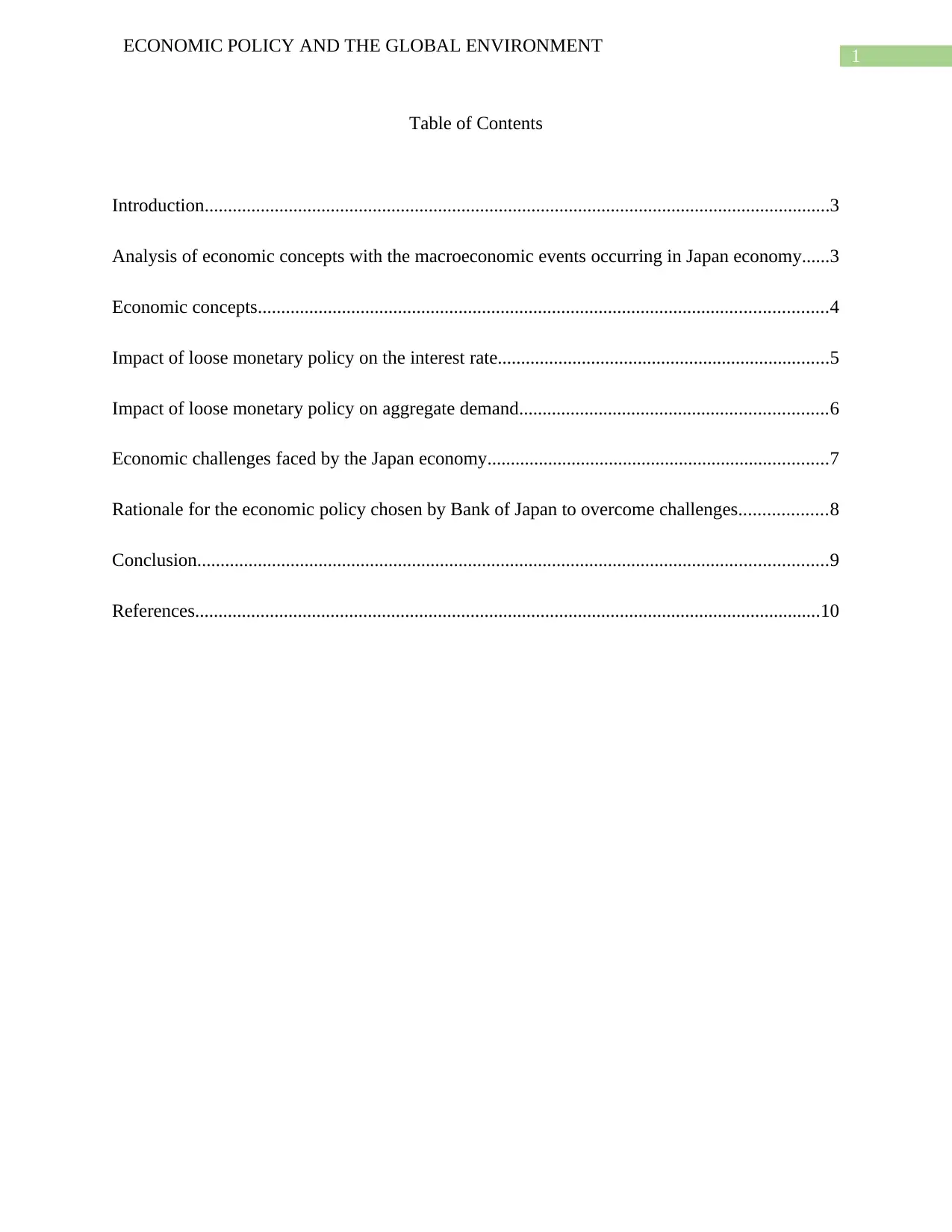
1
ECONOMIC POLICY AND THE GLOBAL ENVIRONMENT
Table of Contents
Introduction......................................................................................................................................3
Analysis of economic concepts with the macroeconomic events occurring in Japan economy......3
Economic concepts..........................................................................................................................4
Impact of loose monetary policy on the interest rate.......................................................................5
Impact of loose monetary policy on aggregate demand..................................................................6
Economic challenges faced by the Japan economy.........................................................................7
Rationale for the economic policy chosen by Bank of Japan to overcome challenges...................8
Conclusion.......................................................................................................................................9
References......................................................................................................................................10
ECONOMIC POLICY AND THE GLOBAL ENVIRONMENT
Table of Contents
Introduction......................................................................................................................................3
Analysis of economic concepts with the macroeconomic events occurring in Japan economy......3
Economic concepts..........................................................................................................................4
Impact of loose monetary policy on the interest rate.......................................................................5
Impact of loose monetary policy on aggregate demand..................................................................6
Economic challenges faced by the Japan economy.........................................................................7
Rationale for the economic policy chosen by Bank of Japan to overcome challenges...................8
Conclusion.......................................................................................................................................9
References......................................................................................................................................10
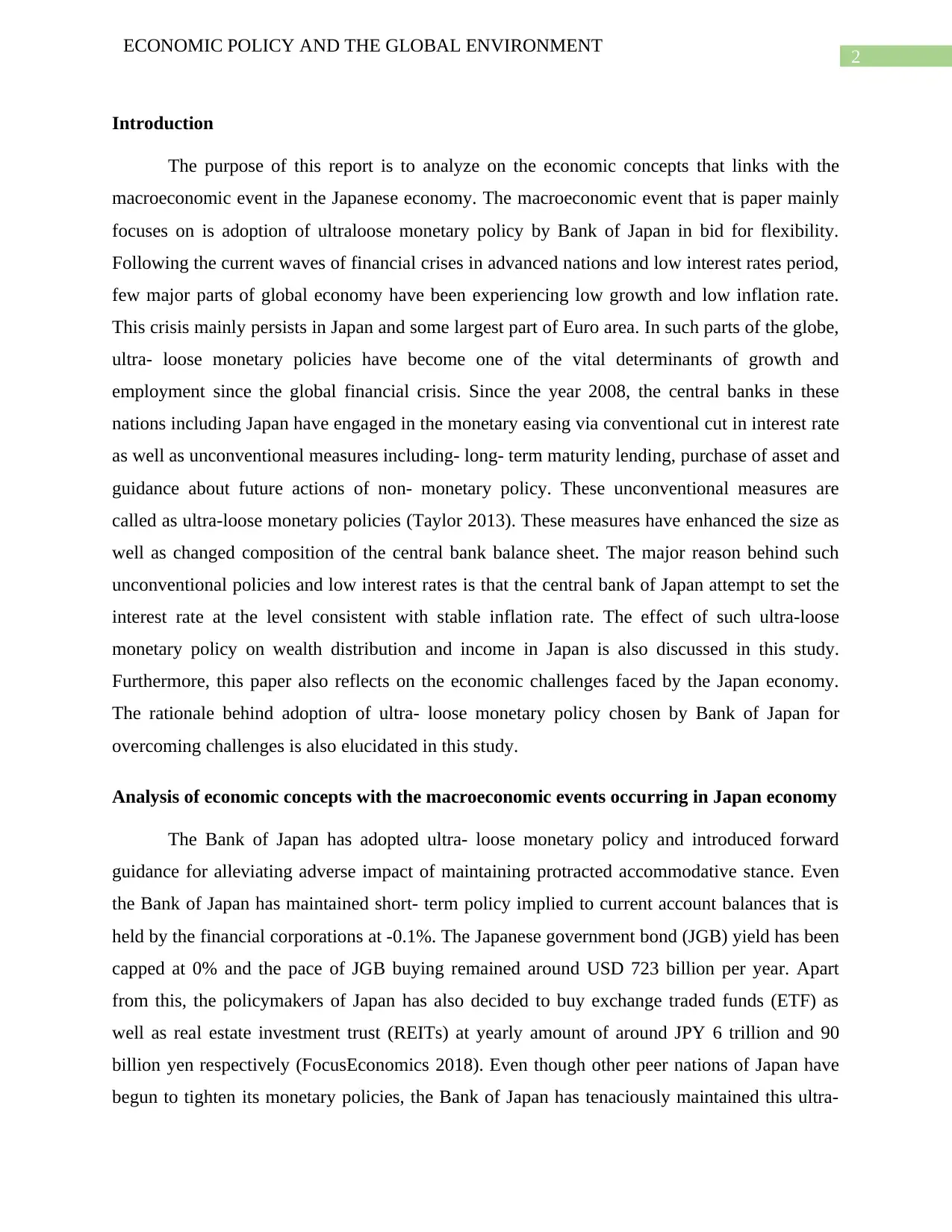
2
ECONOMIC POLICY AND THE GLOBAL ENVIRONMENT
Introduction
The purpose of this report is to analyze on the economic concepts that links with the
macroeconomic event in the Japanese economy. The macroeconomic event that is paper mainly
focuses on is adoption of ultraloose monetary policy by Bank of Japan in bid for flexibility.
Following the current waves of financial crises in advanced nations and low interest rates period,
few major parts of global economy have been experiencing low growth and low inflation rate.
This crisis mainly persists in Japan and some largest part of Euro area. In such parts of the globe,
ultra- loose monetary policies have become one of the vital determinants of growth and
employment since the global financial crisis. Since the year 2008, the central banks in these
nations including Japan have engaged in the monetary easing via conventional cut in interest rate
as well as unconventional measures including- long- term maturity lending, purchase of asset and
guidance about future actions of non- monetary policy. These unconventional measures are
called as ultra-loose monetary policies (Taylor 2013). These measures have enhanced the size as
well as changed composition of the central bank balance sheet. The major reason behind such
unconventional policies and low interest rates is that the central bank of Japan attempt to set the
interest rate at the level consistent with stable inflation rate. The effect of such ultra-loose
monetary policy on wealth distribution and income in Japan is also discussed in this study.
Furthermore, this paper also reflects on the economic challenges faced by the Japan economy.
The rationale behind adoption of ultra- loose monetary policy chosen by Bank of Japan for
overcoming challenges is also elucidated in this study.
Analysis of economic concepts with the macroeconomic events occurring in Japan economy
The Bank of Japan has adopted ultra- loose monetary policy and introduced forward
guidance for alleviating adverse impact of maintaining protracted accommodative stance. Even
the Bank of Japan has maintained short- term policy implied to current account balances that is
held by the financial corporations at -0.1%. The Japanese government bond (JGB) yield has been
capped at 0% and the pace of JGB buying remained around USD 723 billion per year. Apart
from this, the policymakers of Japan has also decided to buy exchange traded funds (ETF) as
well as real estate investment trust (REITs) at yearly amount of around JPY 6 trillion and 90
billion yen respectively (FocusEconomics 2018). Even though other peer nations of Japan have
begun to tighten its monetary policies, the Bank of Japan has tenaciously maintained this ultra-
ECONOMIC POLICY AND THE GLOBAL ENVIRONMENT
Introduction
The purpose of this report is to analyze on the economic concepts that links with the
macroeconomic event in the Japanese economy. The macroeconomic event that is paper mainly
focuses on is adoption of ultraloose monetary policy by Bank of Japan in bid for flexibility.
Following the current waves of financial crises in advanced nations and low interest rates period,
few major parts of global economy have been experiencing low growth and low inflation rate.
This crisis mainly persists in Japan and some largest part of Euro area. In such parts of the globe,
ultra- loose monetary policies have become one of the vital determinants of growth and
employment since the global financial crisis. Since the year 2008, the central banks in these
nations including Japan have engaged in the monetary easing via conventional cut in interest rate
as well as unconventional measures including- long- term maturity lending, purchase of asset and
guidance about future actions of non- monetary policy. These unconventional measures are
called as ultra-loose monetary policies (Taylor 2013). These measures have enhanced the size as
well as changed composition of the central bank balance sheet. The major reason behind such
unconventional policies and low interest rates is that the central bank of Japan attempt to set the
interest rate at the level consistent with stable inflation rate. The effect of such ultra-loose
monetary policy on wealth distribution and income in Japan is also discussed in this study.
Furthermore, this paper also reflects on the economic challenges faced by the Japan economy.
The rationale behind adoption of ultra- loose monetary policy chosen by Bank of Japan for
overcoming challenges is also elucidated in this study.
Analysis of economic concepts with the macroeconomic events occurring in Japan economy
The Bank of Japan has adopted ultra- loose monetary policy and introduced forward
guidance for alleviating adverse impact of maintaining protracted accommodative stance. Even
the Bank of Japan has maintained short- term policy implied to current account balances that is
held by the financial corporations at -0.1%. The Japanese government bond (JGB) yield has been
capped at 0% and the pace of JGB buying remained around USD 723 billion per year. Apart
from this, the policymakers of Japan has also decided to buy exchange traded funds (ETF) as
well as real estate investment trust (REITs) at yearly amount of around JPY 6 trillion and 90
billion yen respectively (FocusEconomics 2018). Even though other peer nations of Japan have
begun to tighten its monetary policies, the Bank of Japan has tenaciously maintained this ultra-
⊘ This is a preview!⊘
Do you want full access?
Subscribe today to unlock all pages.

Trusted by 1+ million students worldwide
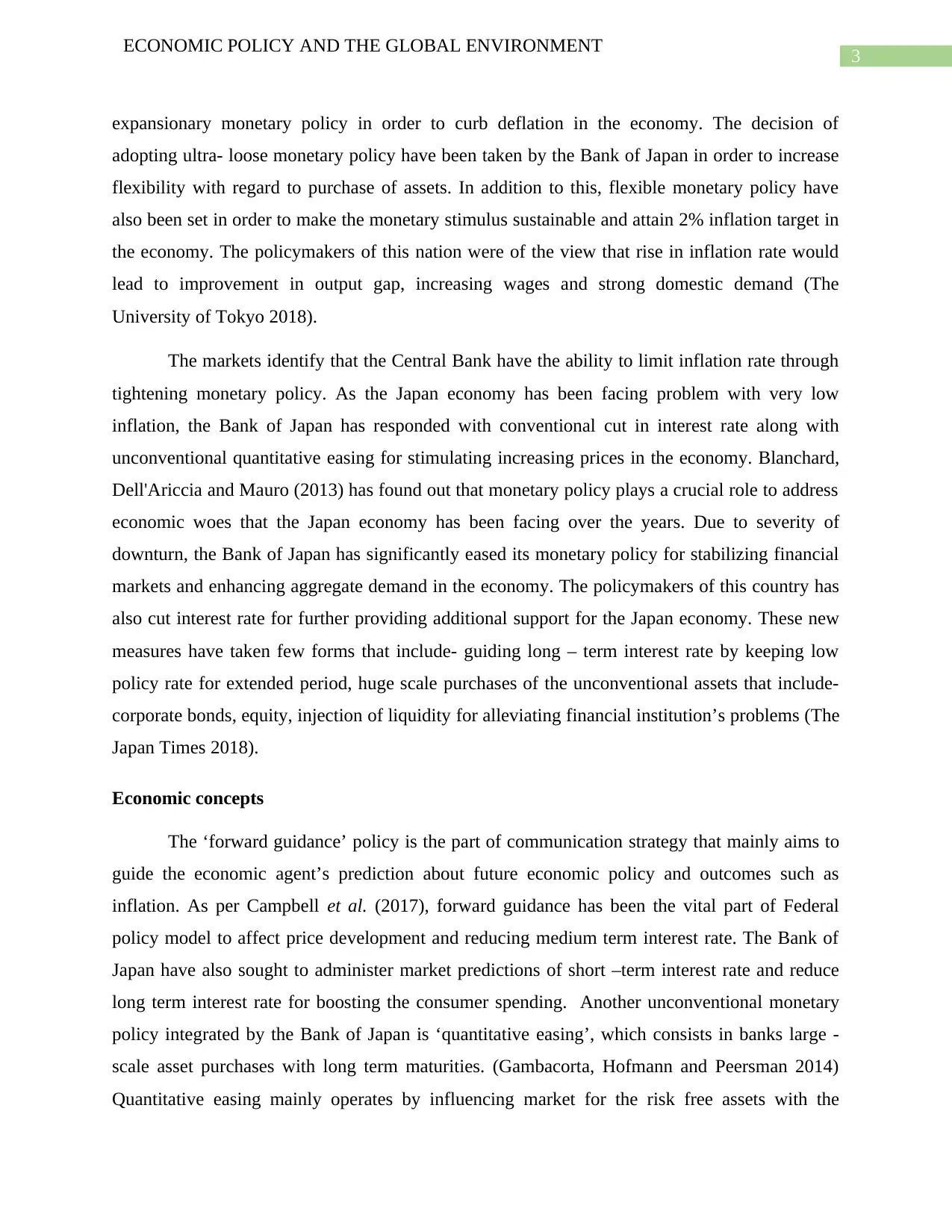
3
ECONOMIC POLICY AND THE GLOBAL ENVIRONMENT
expansionary monetary policy in order to curb deflation in the economy. The decision of
adopting ultra- loose monetary policy have been taken by the Bank of Japan in order to increase
flexibility with regard to purchase of assets. In addition to this, flexible monetary policy have
also been set in order to make the monetary stimulus sustainable and attain 2% inflation target in
the economy. The policymakers of this nation were of the view that rise in inflation rate would
lead to improvement in output gap, increasing wages and strong domestic demand (The
University of Tokyo 2018).
The markets identify that the Central Bank have the ability to limit inflation rate through
tightening monetary policy. As the Japan economy has been facing problem with very low
inflation, the Bank of Japan has responded with conventional cut in interest rate along with
unconventional quantitative easing for stimulating increasing prices in the economy. Blanchard,
Dell'Ariccia and Mauro (2013) has found out that monetary policy plays a crucial role to address
economic woes that the Japan economy has been facing over the years. Due to severity of
downturn, the Bank of Japan has significantly eased its monetary policy for stabilizing financial
markets and enhancing aggregate demand in the economy. The policymakers of this country has
also cut interest rate for further providing additional support for the Japan economy. These new
measures have taken few forms that include- guiding long – term interest rate by keeping low
policy rate for extended period, huge scale purchases of the unconventional assets that include-
corporate bonds, equity, injection of liquidity for alleviating financial institution’s problems (The
Japan Times 2018).
Economic concepts
The ‘forward guidance’ policy is the part of communication strategy that mainly aims to
guide the economic agent’s prediction about future economic policy and outcomes such as
inflation. As per Campbell et al. (2017), forward guidance has been the vital part of Federal
policy model to affect price development and reducing medium term interest rate. The Bank of
Japan have also sought to administer market predictions of short –term interest rate and reduce
long term interest rate for boosting the consumer spending. Another unconventional monetary
policy integrated by the Bank of Japan is ‘quantitative easing’, which consists in banks large -
scale asset purchases with long term maturities. (Gambacorta, Hofmann and Peersman 2014)
Quantitative easing mainly operates by influencing market for the risk free assets with the
ECONOMIC POLICY AND THE GLOBAL ENVIRONMENT
expansionary monetary policy in order to curb deflation in the economy. The decision of
adopting ultra- loose monetary policy have been taken by the Bank of Japan in order to increase
flexibility with regard to purchase of assets. In addition to this, flexible monetary policy have
also been set in order to make the monetary stimulus sustainable and attain 2% inflation target in
the economy. The policymakers of this nation were of the view that rise in inflation rate would
lead to improvement in output gap, increasing wages and strong domestic demand (The
University of Tokyo 2018).
The markets identify that the Central Bank have the ability to limit inflation rate through
tightening monetary policy. As the Japan economy has been facing problem with very low
inflation, the Bank of Japan has responded with conventional cut in interest rate along with
unconventional quantitative easing for stimulating increasing prices in the economy. Blanchard,
Dell'Ariccia and Mauro (2013) has found out that monetary policy plays a crucial role to address
economic woes that the Japan economy has been facing over the years. Due to severity of
downturn, the Bank of Japan has significantly eased its monetary policy for stabilizing financial
markets and enhancing aggregate demand in the economy. The policymakers of this country has
also cut interest rate for further providing additional support for the Japan economy. These new
measures have taken few forms that include- guiding long – term interest rate by keeping low
policy rate for extended period, huge scale purchases of the unconventional assets that include-
corporate bonds, equity, injection of liquidity for alleviating financial institution’s problems (The
Japan Times 2018).
Economic concepts
The ‘forward guidance’ policy is the part of communication strategy that mainly aims to
guide the economic agent’s prediction about future economic policy and outcomes such as
inflation. As per Campbell et al. (2017), forward guidance has been the vital part of Federal
policy model to affect price development and reducing medium term interest rate. The Bank of
Japan have also sought to administer market predictions of short –term interest rate and reduce
long term interest rate for boosting the consumer spending. Another unconventional monetary
policy integrated by the Bank of Japan is ‘quantitative easing’, which consists in banks large -
scale asset purchases with long term maturities. (Gambacorta, Hofmann and Peersman 2014)
Quantitative easing mainly operates by influencing market for the risk free assets with the
Paraphrase This Document
Need a fresh take? Get an instant paraphrase of this document with our AI Paraphraser
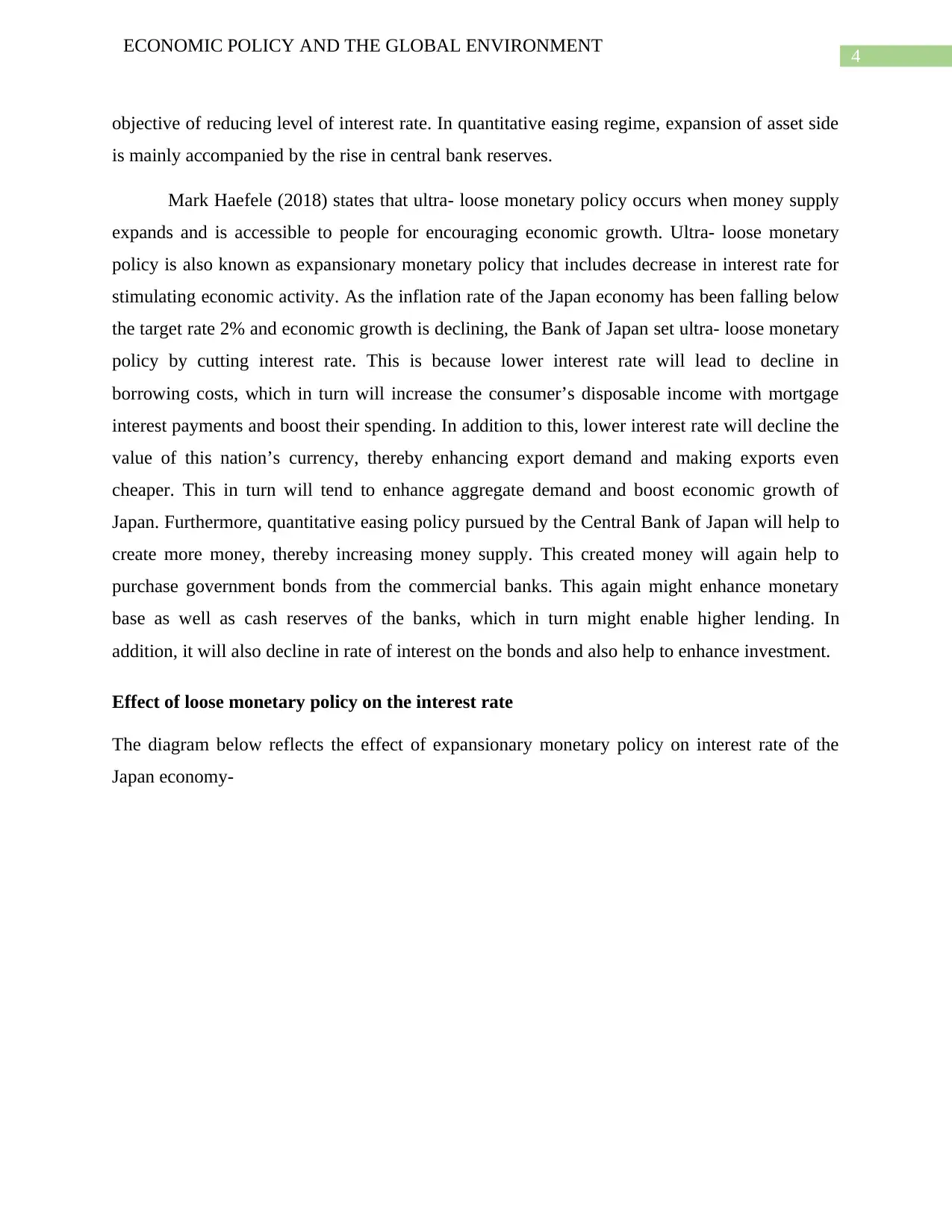
4
ECONOMIC POLICY AND THE GLOBAL ENVIRONMENT
objective of reducing level of interest rate. In quantitative easing regime, expansion of asset side
is mainly accompanied by the rise in central bank reserves.
Mark Haefele (2018) states that ultra- loose monetary policy occurs when money supply
expands and is accessible to people for encouraging economic growth. Ultra- loose monetary
policy is also known as expansionary monetary policy that includes decrease in interest rate for
stimulating economic activity. As the inflation rate of the Japan economy has been falling below
the target rate 2% and economic growth is declining, the Bank of Japan set ultra- loose monetary
policy by cutting interest rate. This is because lower interest rate will lead to decline in
borrowing costs, which in turn will increase the consumer’s disposable income with mortgage
interest payments and boost their spending. In addition to this, lower interest rate will decline the
value of this nation’s currency, thereby enhancing export demand and making exports even
cheaper. This in turn will tend to enhance aggregate demand and boost economic growth of
Japan. Furthermore, quantitative easing policy pursued by the Central Bank of Japan will help to
create more money, thereby increasing money supply. This created money will again help to
purchase government bonds from the commercial banks. This again might enhance monetary
base as well as cash reserves of the banks, which in turn might enable higher lending. In
addition, it will also decline in rate of interest on the bonds and also help to enhance investment.
Effect of loose monetary policy on the interest rate
The diagram below reflects the effect of expansionary monetary policy on interest rate of the
Japan economy-
ECONOMIC POLICY AND THE GLOBAL ENVIRONMENT
objective of reducing level of interest rate. In quantitative easing regime, expansion of asset side
is mainly accompanied by the rise in central bank reserves.
Mark Haefele (2018) states that ultra- loose monetary policy occurs when money supply
expands and is accessible to people for encouraging economic growth. Ultra- loose monetary
policy is also known as expansionary monetary policy that includes decrease in interest rate for
stimulating economic activity. As the inflation rate of the Japan economy has been falling below
the target rate 2% and economic growth is declining, the Bank of Japan set ultra- loose monetary
policy by cutting interest rate. This is because lower interest rate will lead to decline in
borrowing costs, which in turn will increase the consumer’s disposable income with mortgage
interest payments and boost their spending. In addition to this, lower interest rate will decline the
value of this nation’s currency, thereby enhancing export demand and making exports even
cheaper. This in turn will tend to enhance aggregate demand and boost economic growth of
Japan. Furthermore, quantitative easing policy pursued by the Central Bank of Japan will help to
create more money, thereby increasing money supply. This created money will again help to
purchase government bonds from the commercial banks. This again might enhance monetary
base as well as cash reserves of the banks, which in turn might enable higher lending. In
addition, it will also decline in rate of interest on the bonds and also help to enhance investment.
Effect of loose monetary policy on the interest rate
The diagram below reflects the effect of expansionary monetary policy on interest rate of the
Japan economy-
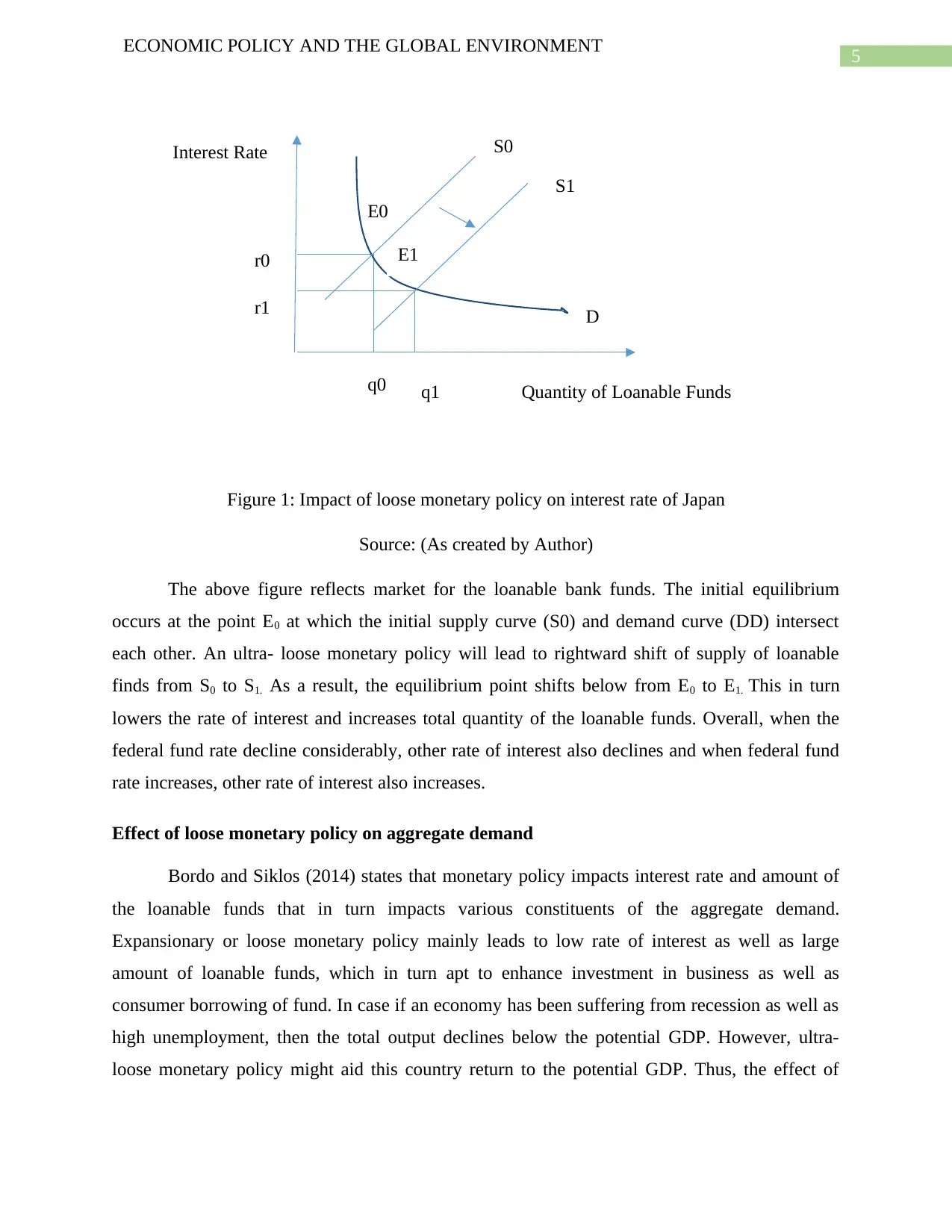
5
ECONOMIC POLICY AND THE GLOBAL ENVIRONMENT
E0
E1
Quantity of Loanable Funds
Interest Rate
D
S0
S1
r0
r1
q0 q1
Figure 1: Impact of loose monetary policy on interest rate of Japan
Source: (As created by Author)
The above figure reflects market for the loanable bank funds. The initial equilibrium
occurs at the point E0 at which the initial supply curve (S0) and demand curve (DD) intersect
each other. An ultra- loose monetary policy will lead to rightward shift of supply of loanable
finds from S0 to S1. As a result, the equilibrium point shifts below from E0 to E1. This in turn
lowers the rate of interest and increases total quantity of the loanable funds. Overall, when the
federal fund rate decline considerably, other rate of interest also declines and when federal fund
rate increases, other rate of interest also increases.
Effect of loose monetary policy on aggregate demand
Bordo and Siklos (2014) states that monetary policy impacts interest rate and amount of
the loanable funds that in turn impacts various constituents of the aggregate demand.
Expansionary or loose monetary policy mainly leads to low rate of interest as well as large
amount of loanable funds, which in turn apt to enhance investment in business as well as
consumer borrowing of fund. In case if an economy has been suffering from recession as well as
high unemployment, then the total output declines below the potential GDP. However, ultra-
loose monetary policy might aid this country return to the potential GDP. Thus, the effect of
ECONOMIC POLICY AND THE GLOBAL ENVIRONMENT
E0
E1
Quantity of Loanable Funds
Interest Rate
D
S0
S1
r0
r1
q0 q1
Figure 1: Impact of loose monetary policy on interest rate of Japan
Source: (As created by Author)
The above figure reflects market for the loanable bank funds. The initial equilibrium
occurs at the point E0 at which the initial supply curve (S0) and demand curve (DD) intersect
each other. An ultra- loose monetary policy will lead to rightward shift of supply of loanable
finds from S0 to S1. As a result, the equilibrium point shifts below from E0 to E1. This in turn
lowers the rate of interest and increases total quantity of the loanable funds. Overall, when the
federal fund rate decline considerably, other rate of interest also declines and when federal fund
rate increases, other rate of interest also increases.
Effect of loose monetary policy on aggregate demand
Bordo and Siklos (2014) states that monetary policy impacts interest rate and amount of
the loanable funds that in turn impacts various constituents of the aggregate demand.
Expansionary or loose monetary policy mainly leads to low rate of interest as well as large
amount of loanable funds, which in turn apt to enhance investment in business as well as
consumer borrowing of fund. In case if an economy has been suffering from recession as well as
high unemployment, then the total output declines below the potential GDP. However, ultra-
loose monetary policy might aid this country return to the potential GDP. Thus, the effect of
⊘ This is a preview!⊘
Do you want full access?
Subscribe today to unlock all pages.

Trusted by 1+ million students worldwide
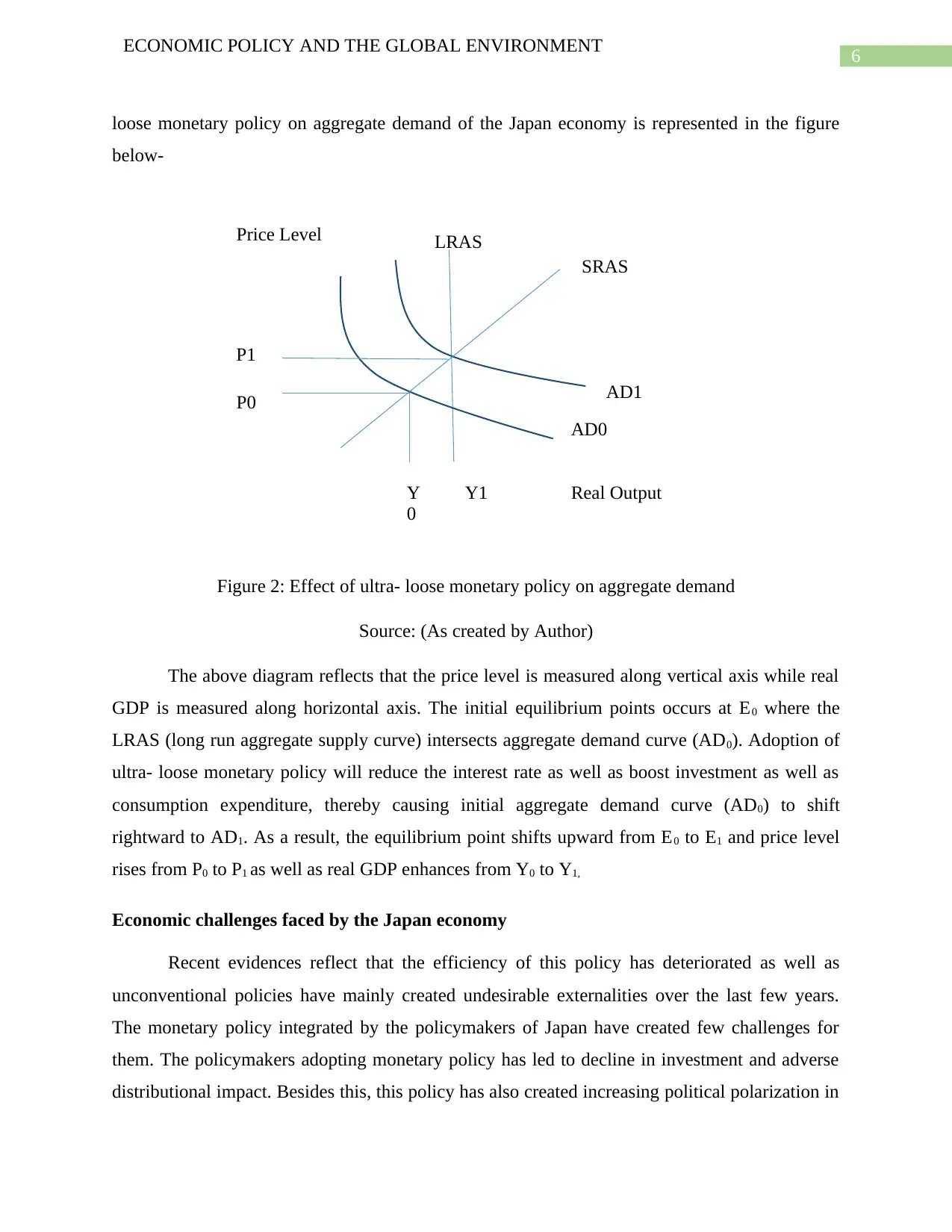
6
ECONOMIC POLICY AND THE GLOBAL ENVIRONMENT
LRAS
SRAS
AD1
AD0
Real Output
Price Level
Y
0
Y1
P0
P1
loose monetary policy on aggregate demand of the Japan economy is represented in the figure
below-
Figure 2: Effect of ultra- loose monetary policy on aggregate demand
Source: (As created by Author)
The above diagram reflects that the price level is measured along vertical axis while real
GDP is measured along horizontal axis. The initial equilibrium points occurs at E0 where the
LRAS (long run aggregate supply curve) intersects aggregate demand curve (AD0). Adoption of
ultra- loose monetary policy will reduce the interest rate as well as boost investment as well as
consumption expenditure, thereby causing initial aggregate demand curve (AD0) to shift
rightward to AD1. As a result, the equilibrium point shifts upward from E0 to E1 and price level
rises from P0 to P1 as well as real GDP enhances from Y0 to Y1,
Economic challenges faced by the Japan economy
Recent evidences reflect that the efficiency of this policy has deteriorated as well as
unconventional policies have mainly created undesirable externalities over the last few years.
The monetary policy integrated by the policymakers of Japan have created few challenges for
them. The policymakers adopting monetary policy has led to decline in investment and adverse
distributional impact. Besides this, this policy has also created increasing political polarization in
ECONOMIC POLICY AND THE GLOBAL ENVIRONMENT
LRAS
SRAS
AD1
AD0
Real Output
Price Level
Y
0
Y1
P0
P1
loose monetary policy on aggregate demand of the Japan economy is represented in the figure
below-
Figure 2: Effect of ultra- loose monetary policy on aggregate demand
Source: (As created by Author)
The above diagram reflects that the price level is measured along vertical axis while real
GDP is measured along horizontal axis. The initial equilibrium points occurs at E0 where the
LRAS (long run aggregate supply curve) intersects aggregate demand curve (AD0). Adoption of
ultra- loose monetary policy will reduce the interest rate as well as boost investment as well as
consumption expenditure, thereby causing initial aggregate demand curve (AD0) to shift
rightward to AD1. As a result, the equilibrium point shifts upward from E0 to E1 and price level
rises from P0 to P1 as well as real GDP enhances from Y0 to Y1,
Economic challenges faced by the Japan economy
Recent evidences reflect that the efficiency of this policy has deteriorated as well as
unconventional policies have mainly created undesirable externalities over the last few years.
The monetary policy integrated by the policymakers of Japan have created few challenges for
them. The policymakers adopting monetary policy has led to decline in investment and adverse
distributional impact. Besides this, this policy has also created increasing political polarization in
Paraphrase This Document
Need a fresh take? Get an instant paraphrase of this document with our AI Paraphraser
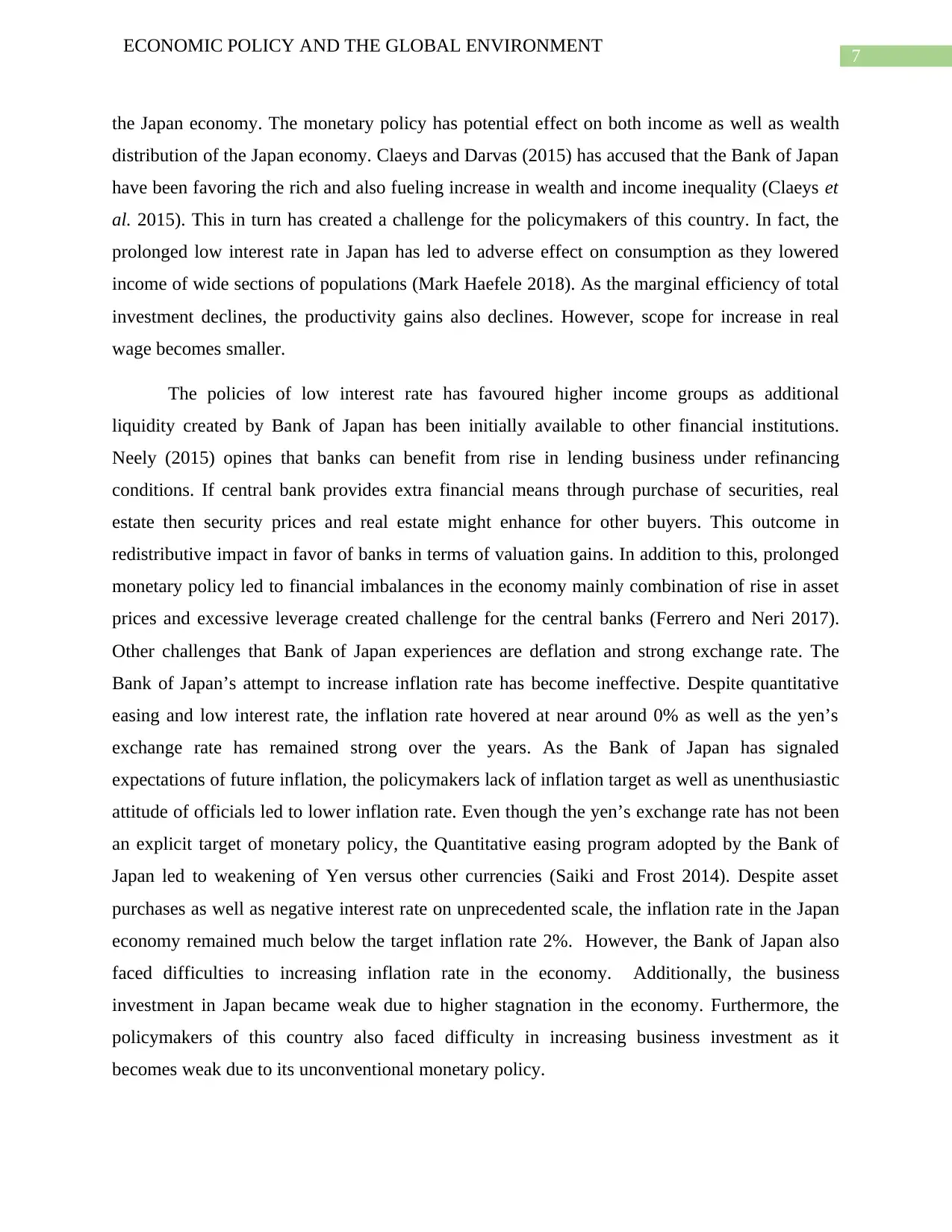
7
ECONOMIC POLICY AND THE GLOBAL ENVIRONMENT
the Japan economy. The monetary policy has potential effect on both income as well as wealth
distribution of the Japan economy. Claeys and Darvas (2015) has accused that the Bank of Japan
have been favoring the rich and also fueling increase in wealth and income inequality (Claeys et
al. 2015). This in turn has created a challenge for the policymakers of this country. In fact, the
prolonged low interest rate in Japan has led to adverse effect on consumption as they lowered
income of wide sections of populations (Mark Haefele 2018). As the marginal efficiency of total
investment declines, the productivity gains also declines. However, scope for increase in real
wage becomes smaller.
The policies of low interest rate has favoured higher income groups as additional
liquidity created by Bank of Japan has been initially available to other financial institutions.
Neely (2015) opines that banks can benefit from rise in lending business under refinancing
conditions. If central bank provides extra financial means through purchase of securities, real
estate then security prices and real estate might enhance for other buyers. This outcome in
redistributive impact in favor of banks in terms of valuation gains. In addition to this, prolonged
monetary policy led to financial imbalances in the economy mainly combination of rise in asset
prices and excessive leverage created challenge for the central banks (Ferrero and Neri 2017).
Other challenges that Bank of Japan experiences are deflation and strong exchange rate. The
Bank of Japan’s attempt to increase inflation rate has become ineffective. Despite quantitative
easing and low interest rate, the inflation rate hovered at near around 0% as well as the yen’s
exchange rate has remained strong over the years. As the Bank of Japan has signaled
expectations of future inflation, the policymakers lack of inflation target as well as unenthusiastic
attitude of officials led to lower inflation rate. Even though the yen’s exchange rate has not been
an explicit target of monetary policy, the Quantitative easing program adopted by the Bank of
Japan led to weakening of Yen versus other currencies (Saiki and Frost 2014). Despite asset
purchases as well as negative interest rate on unprecedented scale, the inflation rate in the Japan
economy remained much below the target inflation rate 2%. However, the Bank of Japan also
faced difficulties to increasing inflation rate in the economy. Additionally, the business
investment in Japan became weak due to higher stagnation in the economy. Furthermore, the
policymakers of this country also faced difficulty in increasing business investment as it
becomes weak due to its unconventional monetary policy.
ECONOMIC POLICY AND THE GLOBAL ENVIRONMENT
the Japan economy. The monetary policy has potential effect on both income as well as wealth
distribution of the Japan economy. Claeys and Darvas (2015) has accused that the Bank of Japan
have been favoring the rich and also fueling increase in wealth and income inequality (Claeys et
al. 2015). This in turn has created a challenge for the policymakers of this country. In fact, the
prolonged low interest rate in Japan has led to adverse effect on consumption as they lowered
income of wide sections of populations (Mark Haefele 2018). As the marginal efficiency of total
investment declines, the productivity gains also declines. However, scope for increase in real
wage becomes smaller.
The policies of low interest rate has favoured higher income groups as additional
liquidity created by Bank of Japan has been initially available to other financial institutions.
Neely (2015) opines that banks can benefit from rise in lending business under refinancing
conditions. If central bank provides extra financial means through purchase of securities, real
estate then security prices and real estate might enhance for other buyers. This outcome in
redistributive impact in favor of banks in terms of valuation gains. In addition to this, prolonged
monetary policy led to financial imbalances in the economy mainly combination of rise in asset
prices and excessive leverage created challenge for the central banks (Ferrero and Neri 2017).
Other challenges that Bank of Japan experiences are deflation and strong exchange rate. The
Bank of Japan’s attempt to increase inflation rate has become ineffective. Despite quantitative
easing and low interest rate, the inflation rate hovered at near around 0% as well as the yen’s
exchange rate has remained strong over the years. As the Bank of Japan has signaled
expectations of future inflation, the policymakers lack of inflation target as well as unenthusiastic
attitude of officials led to lower inflation rate. Even though the yen’s exchange rate has not been
an explicit target of monetary policy, the Quantitative easing program adopted by the Bank of
Japan led to weakening of Yen versus other currencies (Saiki and Frost 2014). Despite asset
purchases as well as negative interest rate on unprecedented scale, the inflation rate in the Japan
economy remained much below the target inflation rate 2%. However, the Bank of Japan also
faced difficulties to increasing inflation rate in the economy. Additionally, the business
investment in Japan became weak due to higher stagnation in the economy. Furthermore, the
policymakers of this country also faced difficulty in increasing business investment as it
becomes weak due to its unconventional monetary policy.
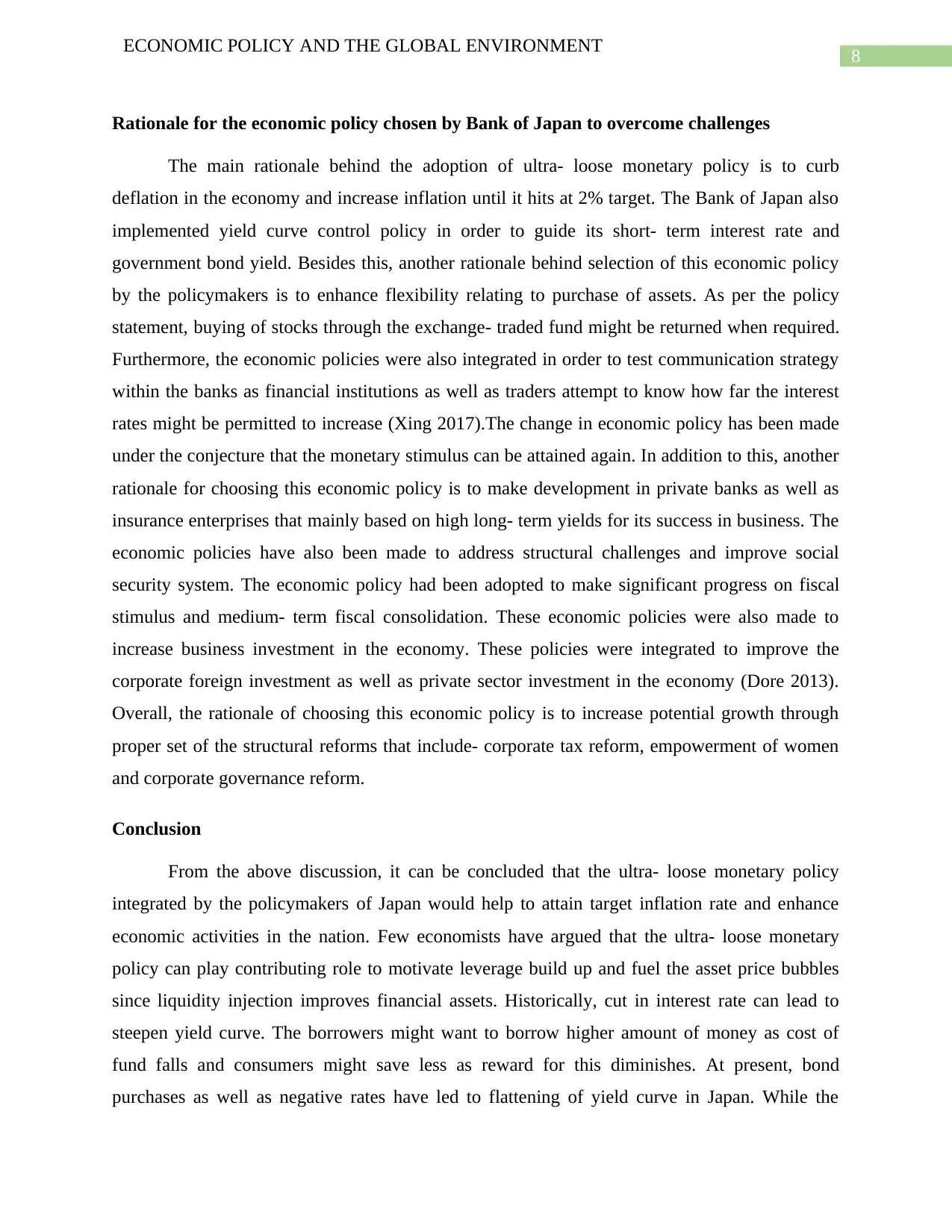
8
ECONOMIC POLICY AND THE GLOBAL ENVIRONMENT
Rationale for the economic policy chosen by Bank of Japan to overcome challenges
The main rationale behind the adoption of ultra- loose monetary policy is to curb
deflation in the economy and increase inflation until it hits at 2% target. The Bank of Japan also
implemented yield curve control policy in order to guide its short- term interest rate and
government bond yield. Besides this, another rationale behind selection of this economic policy
by the policymakers is to enhance flexibility relating to purchase of assets. As per the policy
statement, buying of stocks through the exchange- traded fund might be returned when required.
Furthermore, the economic policies were also integrated in order to test communication strategy
within the banks as financial institutions as well as traders attempt to know how far the interest
rates might be permitted to increase (Xing 2017).The change in economic policy has been made
under the conjecture that the monetary stimulus can be attained again. In addition to this, another
rationale for choosing this economic policy is to make development in private banks as well as
insurance enterprises that mainly based on high long- term yields for its success in business. The
economic policies have also been made to address structural challenges and improve social
security system. The economic policy had been adopted to make significant progress on fiscal
stimulus and medium- term fiscal consolidation. These economic policies were also made to
increase business investment in the economy. These policies were integrated to improve the
corporate foreign investment as well as private sector investment in the economy (Dore 2013).
Overall, the rationale of choosing this economic policy is to increase potential growth through
proper set of the structural reforms that include- corporate tax reform, empowerment of women
and corporate governance reform.
Conclusion
From the above discussion, it can be concluded that the ultra- loose monetary policy
integrated by the policymakers of Japan would help to attain target inflation rate and enhance
economic activities in the nation. Few economists have argued that the ultra- loose monetary
policy can play contributing role to motivate leverage build up and fuel the asset price bubbles
since liquidity injection improves financial assets. Historically, cut in interest rate can lead to
steepen yield curve. The borrowers might want to borrow higher amount of money as cost of
fund falls and consumers might save less as reward for this diminishes. At present, bond
purchases as well as negative rates have led to flattening of yield curve in Japan. While the
ECONOMIC POLICY AND THE GLOBAL ENVIRONMENT
Rationale for the economic policy chosen by Bank of Japan to overcome challenges
The main rationale behind the adoption of ultra- loose monetary policy is to curb
deflation in the economy and increase inflation until it hits at 2% target. The Bank of Japan also
implemented yield curve control policy in order to guide its short- term interest rate and
government bond yield. Besides this, another rationale behind selection of this economic policy
by the policymakers is to enhance flexibility relating to purchase of assets. As per the policy
statement, buying of stocks through the exchange- traded fund might be returned when required.
Furthermore, the economic policies were also integrated in order to test communication strategy
within the banks as financial institutions as well as traders attempt to know how far the interest
rates might be permitted to increase (Xing 2017).The change in economic policy has been made
under the conjecture that the monetary stimulus can be attained again. In addition to this, another
rationale for choosing this economic policy is to make development in private banks as well as
insurance enterprises that mainly based on high long- term yields for its success in business. The
economic policies have also been made to address structural challenges and improve social
security system. The economic policy had been adopted to make significant progress on fiscal
stimulus and medium- term fiscal consolidation. These economic policies were also made to
increase business investment in the economy. These policies were integrated to improve the
corporate foreign investment as well as private sector investment in the economy (Dore 2013).
Overall, the rationale of choosing this economic policy is to increase potential growth through
proper set of the structural reforms that include- corporate tax reform, empowerment of women
and corporate governance reform.
Conclusion
From the above discussion, it can be concluded that the ultra- loose monetary policy
integrated by the policymakers of Japan would help to attain target inflation rate and enhance
economic activities in the nation. Few economists have argued that the ultra- loose monetary
policy can play contributing role to motivate leverage build up and fuel the asset price bubbles
since liquidity injection improves financial assets. Historically, cut in interest rate can lead to
steepen yield curve. The borrowers might want to borrow higher amount of money as cost of
fund falls and consumers might save less as reward for this diminishes. At present, bond
purchases as well as negative rates have led to flattening of yield curve in Japan. While the
⊘ This is a preview!⊘
Do you want full access?
Subscribe today to unlock all pages.

Trusted by 1+ million students worldwide
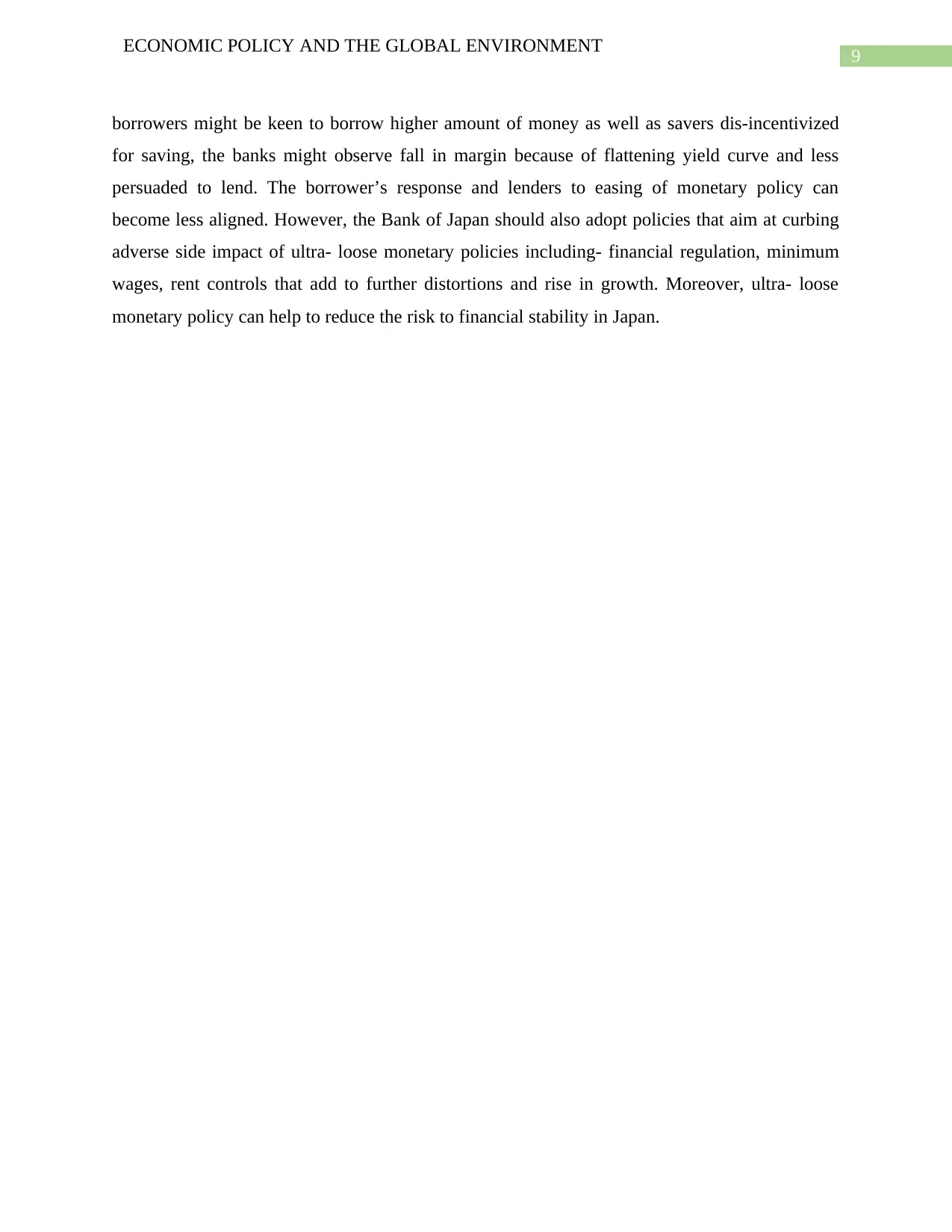
9
ECONOMIC POLICY AND THE GLOBAL ENVIRONMENT
borrowers might be keen to borrow higher amount of money as well as savers dis-incentivized
for saving, the banks might observe fall in margin because of flattening yield curve and less
persuaded to lend. The borrower’s response and lenders to easing of monetary policy can
become less aligned. However, the Bank of Japan should also adopt policies that aim at curbing
adverse side impact of ultra- loose monetary policies including- financial regulation, minimum
wages, rent controls that add to further distortions and rise in growth. Moreover, ultra- loose
monetary policy can help to reduce the risk to financial stability in Japan.
ECONOMIC POLICY AND THE GLOBAL ENVIRONMENT
borrowers might be keen to borrow higher amount of money as well as savers dis-incentivized
for saving, the banks might observe fall in margin because of flattening yield curve and less
persuaded to lend. The borrower’s response and lenders to easing of monetary policy can
become less aligned. However, the Bank of Japan should also adopt policies that aim at curbing
adverse side impact of ultra- loose monetary policies including- financial regulation, minimum
wages, rent controls that add to further distortions and rise in growth. Moreover, ultra- loose
monetary policy can help to reduce the risk to financial stability in Japan.
Paraphrase This Document
Need a fresh take? Get an instant paraphrase of this document with our AI Paraphraser
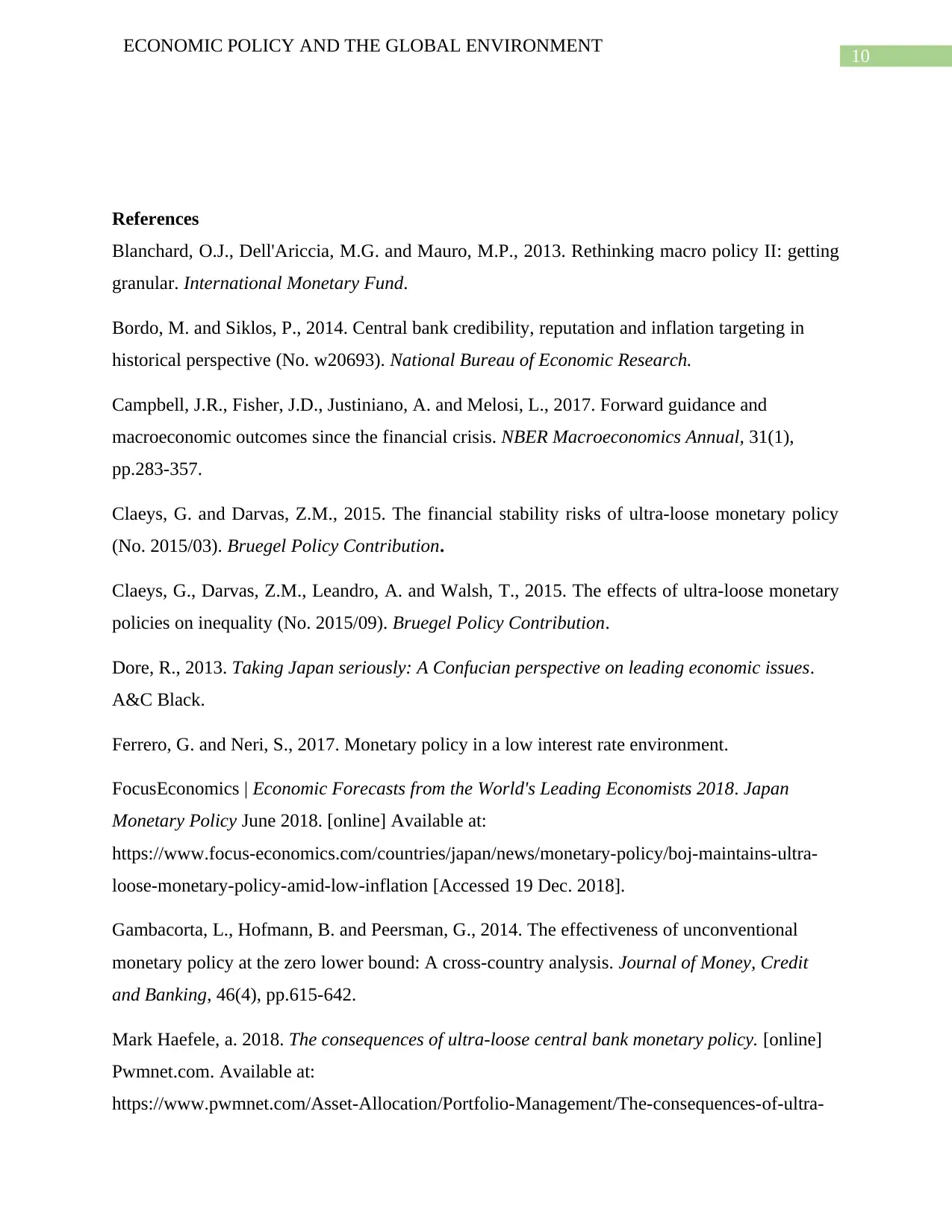
10
ECONOMIC POLICY AND THE GLOBAL ENVIRONMENT
References
Blanchard, O.J., Dell'Ariccia, M.G. and Mauro, M.P., 2013. Rethinking macro policy II: getting
granular. International Monetary Fund.
Bordo, M. and Siklos, P., 2014. Central bank credibility, reputation and inflation targeting in
historical perspective (No. w20693). National Bureau of Economic Research.
Campbell, J.R., Fisher, J.D., Justiniano, A. and Melosi, L., 2017. Forward guidance and
macroeconomic outcomes since the financial crisis. NBER Macroeconomics Annual, 31(1),
pp.283-357.
Claeys, G. and Darvas, Z.M., 2015. The financial stability risks of ultra-loose monetary policy
(No. 2015/03). Bruegel Policy Contribution.
Claeys, G., Darvas, Z.M., Leandro, A. and Walsh, T., 2015. The effects of ultra-loose monetary
policies on inequality (No. 2015/09). Bruegel Policy Contribution.
Dore, R., 2013. Taking Japan seriously: A Confucian perspective on leading economic issues.
A&C Black.
Ferrero, G. and Neri, S., 2017. Monetary policy in a low interest rate environment.
FocusEconomics | Economic Forecasts from the World's Leading Economists 2018. Japan
Monetary Policy June 2018. [online] Available at:
https://www.focus-economics.com/countries/japan/news/monetary-policy/boj-maintains-ultra-
loose-monetary-policy-amid-low-inflation [Accessed 19 Dec. 2018].
Gambacorta, L., Hofmann, B. and Peersman, G., 2014. The effectiveness of unconventional
monetary policy at the zero lower bound: A cross‐country analysis. Journal of Money, Credit
and Banking, 46(4), pp.615-642.
Mark Haefele, a. 2018. The consequences of ultra-loose central bank monetary policy. [online]
Pwmnet.com. Available at:
https://www.pwmnet.com/Asset-Allocation/Portfolio-Management/The-consequences-of-ultra-
ECONOMIC POLICY AND THE GLOBAL ENVIRONMENT
References
Blanchard, O.J., Dell'Ariccia, M.G. and Mauro, M.P., 2013. Rethinking macro policy II: getting
granular. International Monetary Fund.
Bordo, M. and Siklos, P., 2014. Central bank credibility, reputation and inflation targeting in
historical perspective (No. w20693). National Bureau of Economic Research.
Campbell, J.R., Fisher, J.D., Justiniano, A. and Melosi, L., 2017. Forward guidance and
macroeconomic outcomes since the financial crisis. NBER Macroeconomics Annual, 31(1),
pp.283-357.
Claeys, G. and Darvas, Z.M., 2015. The financial stability risks of ultra-loose monetary policy
(No. 2015/03). Bruegel Policy Contribution.
Claeys, G., Darvas, Z.M., Leandro, A. and Walsh, T., 2015. The effects of ultra-loose monetary
policies on inequality (No. 2015/09). Bruegel Policy Contribution.
Dore, R., 2013. Taking Japan seriously: A Confucian perspective on leading economic issues.
A&C Black.
Ferrero, G. and Neri, S., 2017. Monetary policy in a low interest rate environment.
FocusEconomics | Economic Forecasts from the World's Leading Economists 2018. Japan
Monetary Policy June 2018. [online] Available at:
https://www.focus-economics.com/countries/japan/news/monetary-policy/boj-maintains-ultra-
loose-monetary-policy-amid-low-inflation [Accessed 19 Dec. 2018].
Gambacorta, L., Hofmann, B. and Peersman, G., 2014. The effectiveness of unconventional
monetary policy at the zero lower bound: A cross‐country analysis. Journal of Money, Credit
and Banking, 46(4), pp.615-642.
Mark Haefele, a. 2018. The consequences of ultra-loose central bank monetary policy. [online]
Pwmnet.com. Available at:
https://www.pwmnet.com/Asset-Allocation/Portfolio-Management/The-consequences-of-ultra-
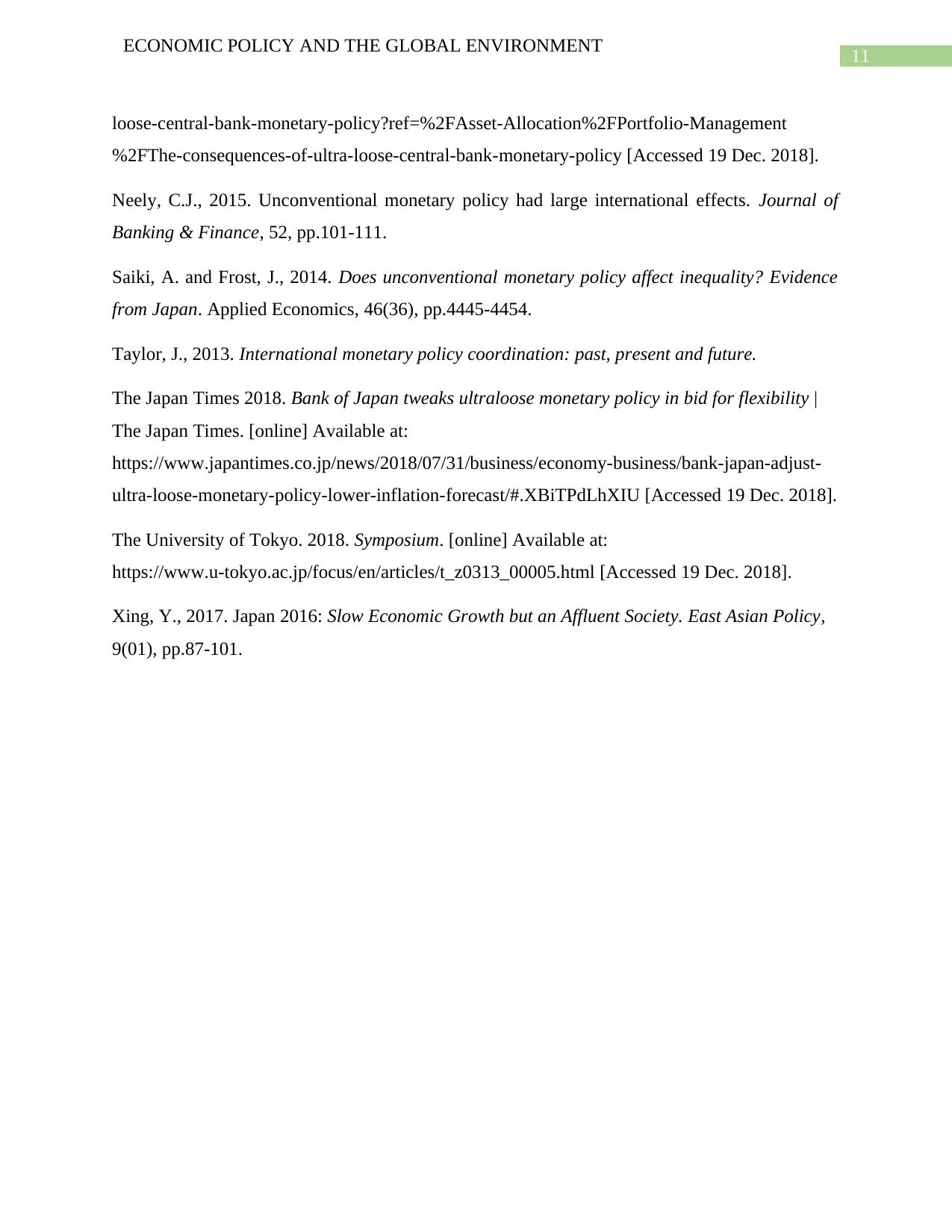
11
ECONOMIC POLICY AND THE GLOBAL ENVIRONMENT
loose-central-bank-monetary-policy?ref=%2FAsset-Allocation%2FPortfolio-Management
%2FThe-consequences-of-ultra-loose-central-bank-monetary-policy [Accessed 19 Dec. 2018].
Neely, C.J., 2015. Unconventional monetary policy had large international effects. Journal of
Banking & Finance, 52, pp.101-111.
Saiki, A. and Frost, J., 2014. Does unconventional monetary policy affect inequality? Evidence
from Japan. Applied Economics, 46(36), pp.4445-4454.
Taylor, J., 2013. International monetary policy coordination: past, present and future.
The Japan Times 2018. Bank of Japan tweaks ultraloose monetary policy in bid for flexibility |
The Japan Times. [online] Available at:
https://www.japantimes.co.jp/news/2018/07/31/business/economy-business/bank-japan-adjust-
ultra-loose-monetary-policy-lower-inflation-forecast/#.XBiTPdLhXIU [Accessed 19 Dec. 2018].
The University of Tokyo. 2018. Symposium. [online] Available at:
https://www.u-tokyo.ac.jp/focus/en/articles/t_z0313_00005.html [Accessed 19 Dec. 2018].
Xing, Y., 2017. Japan 2016: Slow Economic Growth but an Affluent Society. East Asian Policy,
9(01), pp.87-101.
ECONOMIC POLICY AND THE GLOBAL ENVIRONMENT
loose-central-bank-monetary-policy?ref=%2FAsset-Allocation%2FPortfolio-Management
%2FThe-consequences-of-ultra-loose-central-bank-monetary-policy [Accessed 19 Dec. 2018].
Neely, C.J., 2015. Unconventional monetary policy had large international effects. Journal of
Banking & Finance, 52, pp.101-111.
Saiki, A. and Frost, J., 2014. Does unconventional monetary policy affect inequality? Evidence
from Japan. Applied Economics, 46(36), pp.4445-4454.
Taylor, J., 2013. International monetary policy coordination: past, present and future.
The Japan Times 2018. Bank of Japan tweaks ultraloose monetary policy in bid for flexibility |
The Japan Times. [online] Available at:
https://www.japantimes.co.jp/news/2018/07/31/business/economy-business/bank-japan-adjust-
ultra-loose-monetary-policy-lower-inflation-forecast/#.XBiTPdLhXIU [Accessed 19 Dec. 2018].
The University of Tokyo. 2018. Symposium. [online] Available at:
https://www.u-tokyo.ac.jp/focus/en/articles/t_z0313_00005.html [Accessed 19 Dec. 2018].
Xing, Y., 2017. Japan 2016: Slow Economic Growth but an Affluent Society. East Asian Policy,
9(01), pp.87-101.
⊘ This is a preview!⊘
Do you want full access?
Subscribe today to unlock all pages.

Trusted by 1+ million students worldwide
1 out of 12
Related Documents
Your All-in-One AI-Powered Toolkit for Academic Success.
+13062052269
info@desklib.com
Available 24*7 on WhatsApp / Email
![[object Object]](/_next/static/media/star-bottom.7253800d.svg)
Unlock your academic potential
Copyright © 2020–2025 A2Z Services. All Rights Reserved. Developed and managed by ZUCOL.





